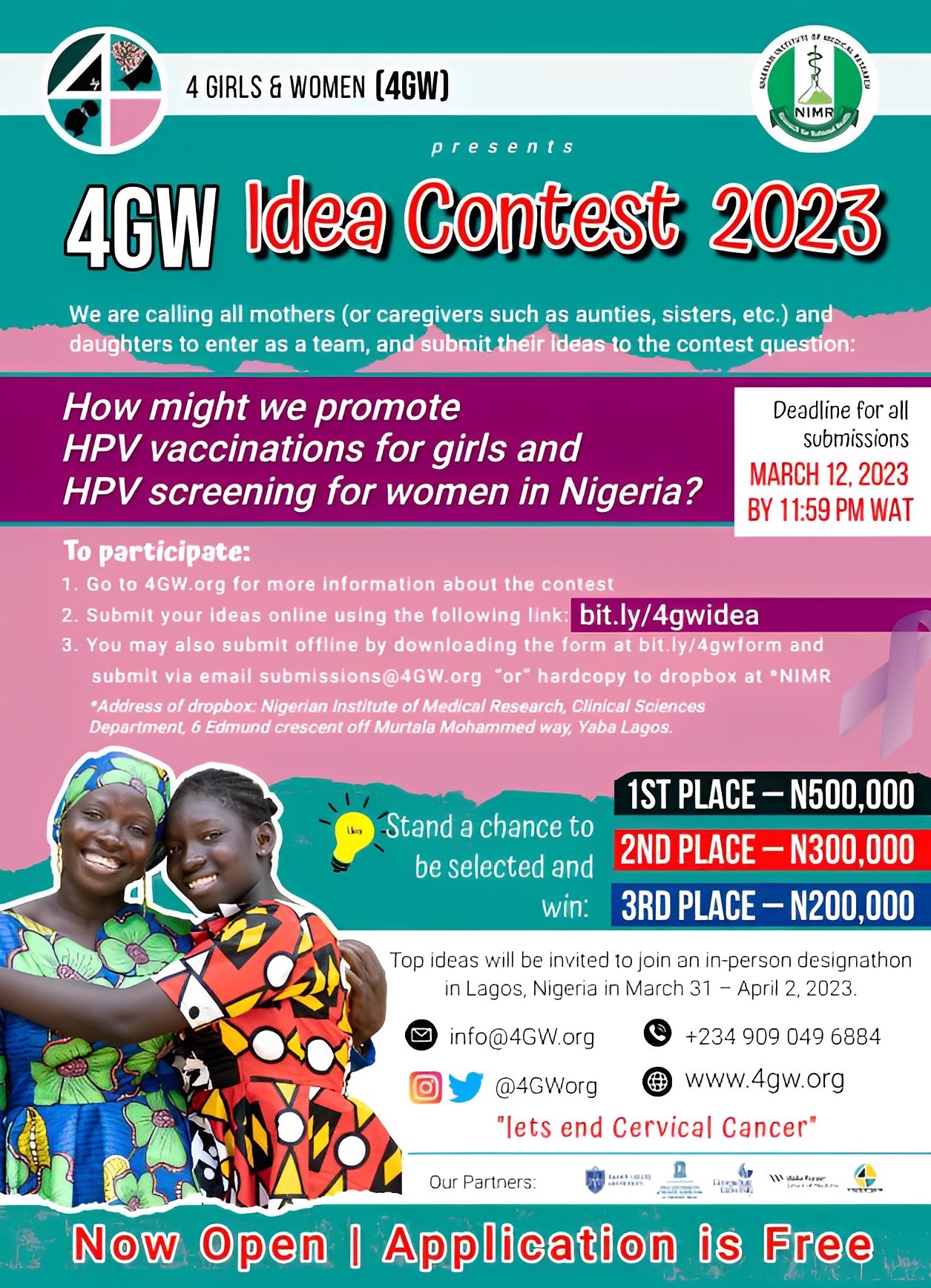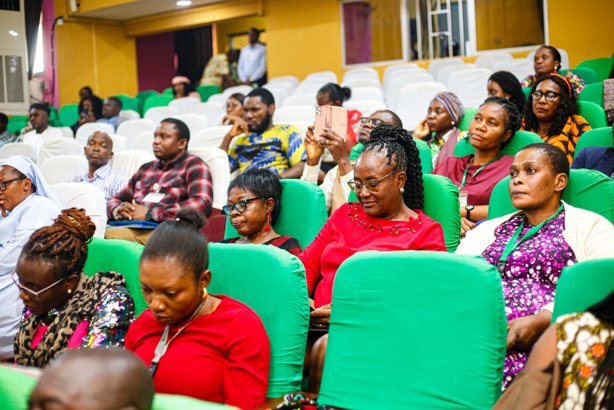Media Chat with Prof. Oliver Ezechi on Cervical Cancer Awareness.
Professor Ezechi Oliver
Can you please introduce yourself?
I am Professor Ezechi Oliver. I am a Director of Research at the Clinical Sciences Department of the Nigerian Institute of Medical Research. I am also a consultant obstetrician-gynaecologist.
We are aware of your recent project on cervical cancer awareness and screening among girls and women in Nigeria; please tell us more about it.
For years, NIMR has been involved in the cervical cancer screening of women living with HIV/AIDS, as well as those who are HIV-negative. Although we focus primarily on research, we also provide health services to people while conducting research.
This year 2023, we received two NIH (National Institutes of Health) grants to expand our cervical cancer screening.
The first is the Actions for Collaborative Community Engaged Strategies for Human Papilloma Virus (ACCESS-HPV) programme and the second is the CHESS project.
We will conduct the cervical cancer screening not only in Lagos and Ogun states, which have been our focus but in all thirty-six states of the federation so that more women and young girls can have access to cervical cancer screening.
ACCESS-HPV PROJECT
Actions for Collaborative Community Engaged Strategies for Human Papilloma Virus (ACCESS-HPV) programme
 CHESS PROJECT
CHESS PROJECT
(Community, Home-Based Education, Screening Services.)
Strategy to increase cervical control access for HIV-positive women in Nigeria
Cervical cancer is the leading cause of death in women and it is second only to breast cancer among women. Every day, about 28 new cases of cervical cancer are reportedly diagnosed, and about 22 people are likely to die of the disease.
A disease that kills about 22 people daily demonstrates the importance of implementing strong preventive measures. Imagine a plane carrying 22 people crashing in Nigeria in one day; the entire news will cover it, so having 22 women dying daily tells you that this is something the country should take seriously, and find means of prevention.
The beauty of it all is that cervical cancer is avoidable through the immunization of young girls and the screening of women. It is also treatable if detected early. If we want to join other nations’ committees in eliminating cervical cancer by 2030, we must do what the WHO recommends each country do, which is to vaccinate 90% of girls. Girls aged 9 to 15 years old need to be vaccinated, and 70% of women diagnosed with cervical cancer need effective interventions. These are doable at low-cost measures, and prevention is both cheaper and more effective than treatment. However, most women present very late either at stages two, three and four of cervical cancer, when there is little chance of a total cure and with the option of managing what we call tertiary prevention. Therefore, the focus of this grant will be prevention, prevention, and prevention. We will treat those found to be infected.
What is the prevalence of cervical cancer in Nigeria and why is the awareness of voluntary screening among girls and women important?
Cervical cancer is the second most common cancer after breast cancer. About 28 new cases are diagnosed daily, and 22 of these reported cases die, and this shows how common it is. Over time, awareness has grown, but it is still not where it ought to be. Even when there is awareness, the uptake of these services is poor due to issues ranging from cultural practices, poor health-seeking behaviour, religious beliefs, and denials due to religious beliefs. Some people do not invest in their health, but would rather spend money on festive celebrations and social frivolities.
The national program priorities do not include screening and vaccination of human papillomavirus, hence, our programme intends to vaccinate your young girls between the ages of 9 and 15, which hitherto expect people to pay for it out of pocket, despite not being easily affordable for the average Nigerian, and part of the reasons for the low case detection, and poor treatment of cervical cancer in the country. Through our programme, we hope to do to improve access, which may not be enough; but will improve the level of awareness, screening, and early treatment, and reduce in mortality rate from cervical cancer.
What are the constraints to cervical cancer screening in Nigeria and sub-Saharan Africa?
The main constraint is poor screening awareness, availability of human papillomavirus vaccine, high cost of treatment and poor healthcare-seeking behaviour, particularly for a disease with almost no symptoms in the early stages. People would usually wait until the symptoms appear before seeking care, and at that point, it may be too late. In addition, cultural practices and low level of education of some women and the proximity of women living in rural areas to healthcare services and financial incapabilities contribute to low awareness and voluntary screening for cervical cancer by women.
Again, screening entails a woman visiting a facility and then opening her legs to allow a health worker to collect a sample. Cultural and religious practices discourage a significant percentage of women from having such exposures without the approval and or involvement of their husbands. In certain cases, some women only submit themselves to female health practitioners for screening. Yet, the country does not have enough female gynecologists or doctors to undertake to screen. There are cases of women seeking the consent of their husbands to visit a facility with a male doctor, and not being able to get the consent of the men. But thankfully, we now have self-testing procedures which allow women to simply collect the kits, go home or use a bathroom and collect the samples, and return them. So, with this newly proposed project, we hope to increase screening uptake.
Is the sample self-collection kit identical to a swab test kit?
Yes, the sample collector works similarly to a swab. It involves simply bending down and inserting the swab stick (with simple instructions) to collect the sample and return it to the health workers. So, we hope that self sample-collection procedure will solve many challenges preventing a lot of women from going to a health facility and those prevented by spouses and religious beliefs about being screened by male doctors.
How does cervical cancer impact the family, workforce, and public health situation in the country?
Of course, we all know that women run the home, so imagine the effect of the loss of a mother, sister, or daughter in a family. Cancer usually kills women at an age when they are most productive to the family and the nation. When a woman dies from cervical cancer, she leaves behind a family, a nation, and an institution.

Is the ACCESS-HPV project focusing on both rural, semi-rural, and urban communities in the country?
It is for all Nigerians. We are doing something similar to what we are doing now in a program called ITEST, where we are in 60 local governments across the country, spread across 36 states. We will expand it for this project so that we can cover all states.
But, as you are aware, this grant cannot solve the entire country’s problems; it is only a supplement. It is NIMR’s contribution to improving the health status of women in Nigeria.
What are your strategies for community engagement, especially in the hard-to-reach areas in the country?
To reach everyone, including those in rural communities and hard-to-reach areas, we first held a stakeholder meeting to which we invited about 30 pressmen. We understand that we may not be able to visit those locations, but we are hopeful that through our engagement with the press, we will be able to reach every part of the country with the message of awareness and availability of screening programs. And from the information we have received thus far, it is clear that the information is spreading. We are also using social media to reach people; we know that people in hard-to-reach areas use cell phones, so we are using that to reach as many people as possible, but we are aware that this single project will not be enough.
Are there vaccines against the human papillomavirus and are they readily available in the country?
Yes, there is a Human papillomavirus vaccine available. We have bivalent and quadrivalent vaccines that are designed to target the two types of HPV that cause 70% of the virus. They are widely available, but they are not part of the national program; they are not yet a part of the national immunization program, though the government is working to change that. The government planned it for the fourth quarter of 2020, but COVID-19 delayed it. Hopefully, by the end of this year, it would have been part of the national health program, but it is available in the country’s private health sector. It is a commitment that all parents should make in their daughter’s life between the ages of 9 and 15. Mothers need to be informed on when and how their daughters can receive vaccination against cervical cancer. Previously, the vaccine required three shots, but it has now they have reduced it to a single shot.
Is there treatment a component of the awareness and screening programme, or will there be referrals for treatment for those positive for the screening?
Yes, as we raise awareness and screening, those who are positive and at the early stage of the disease will receive treatment, but we will refer anyone in the advanced stage to teaching hospitals where they can receive adequate treatment.
Does NIMR have adequate human resources and equipment to carry out this programme?
Of course, NIMR is the country’s apex medical research institute, and our mandate is to conduct research into diseases of public health importance, of which cervical cancer is one. Who is required to conduct cervical cancer research? You need public health physicians, gynaecologists, and nurses, all of which NIMR has. NIMR has everything we need to get started. However, we recognize that we cannot accomplish this alone, which is why we are collaborating with colleagues from US institutions such as St. Louis University and the University of North Carolina, as well as other institutions in Nigeria such as the University of Ibadan, Nnamdi Azikiwe University in Awka, and Aminu Kano University teaching hospital, Kano. We are also partnering with other like-minded organizations to ensure that we have the capacity and reach to run these services.
How achievable is the WHO’s goal of eradicating cervical cancer by 2030?
Achieving WHO’s goal of eradicating cervical cancer by 2030 entails striving to ensure that all young girls between the ages of 9 and 15 receive vaccination, and women between the ages of 30 and 60 receive screening for cervical cancer to detect cases of cervical cancer at an early stage and receive treatment and cure. Many countries are already on track to do so, so we are urging the government and politicians to redouble their efforts to ensure that Nigeria joins the committee of nations working to eradicate cervical cancer by 2030. And no one will probably not be talking about cervical cancer in ten or twenty years.
What happens to girls aged 16-29 not included in being screened and vaccinated?
It is not possible to solve every problem; therefore, a target group is considered important to receive the vaccination. Evidence suggests that the vaccination is most effective in children aged 9 to 15. If a woman is 25 years old and has not had sex, she can still get the vaccine; however, it is not as effective as when she is 9-15 years old. When you have limited resources, you will deploy them where they can be most effectively utilized. Women at age 30 can then receive screening.
How can we contribute to the campaign of getting girls and women in our communities vaccinated and screened?
They should be directed to go to any teaching hospital or federal medical centre, and even general hospitals in Lagos state, to screen for cervical cancer. It is something that even a nurse can do; all it takes is training, and most people in these healthcare facilities have been trained.
Can vaccination and screening extend to healthcare centres as well?
Nobody wants to do anything that can lead to false-negative results. One must be certain when claiming that someone has cancer. Nobody just screens people and tells them they have early-stage cancer without valid evidence. That can be fatal on its own, so you don’t want to scale down screening to the level of care without adequate training and qualified health human resources to provide vaccination and screening.
Is the Pap smear test what determines whether someone has cervical cancer?
A pap smear test is like waiting for the disease to develop and detect it, but HPV testing determines the organism that causes cervical cancer so that treatment can begin before it transforms. The Human papillomavirus will first affect the cervix. The Human papillomavirus attacks the cervix first. It will affect the cervix’s squamocolumnar junction (SCJ) and from there, the body will have a way of preventing it from sitting, but some of them survive and then transform into cervical cancer, which is why cervical cancer is common among HIV-positive people because their immunity is low and their body is unable to prevent the HPV from transforming to cervical cancer. The HPV test is the better option, but if a pap smear is all that is available, that is also an option.
Is it affordable to have a cervical cancer vaccine/screening?
People have phones worth hundreds of thousands of naira, and some have phones worth a million naira. People buy expensive clothes and shoes, so, people should prioritize their healthcare and invest in it. Our toughest challenge is people’s negative attitude toward healthcare. Everyone puts money aside for school fees and festivities, but how many people put money aside for their healthcare? Only very few people probably do! You say you’re putting money aside for your daughter’s wedding, so why not invest in her well-being by getting her vaccinated against HPV? That’s a fantastic investment. When parents build houses for children to inherit, the children will have to be still alive to inherit them. If she is still alive, she can earn far more money than the house or money you want to save for her.
How much does the cervical cancer vaccine cost?
I can’t say how much it is right now, but it’s not more than ₦10,000 for a single shot.
What happens if you are screened and tested positive?
We provide viable treatment. That is why it is critical to detect it as soon as possible. If we detected it between the ages of 16 and 18, we will either perform a colposcopy or a visual inspection, and if there is a vision, it is an office procedure; we will simply circulate the cervix, and that is it. If the woman has finished her family, we will just remove the entire transformation zone, but if she is still having children, she will receive therapy and that’s it. It’s that simple, and it’s the essence of detecting it early, just like breast examination. If we discover a lump early, it can be removed quickly; however, despite increased awareness, people continue to be diagnosed with breast cancer. But we’ll keep talking and preaching; one day, our women will listen. We are sending flyers and letters to all women’s organizations in Lagos, including market women, medical women’s associations, Islamic women’s associations, Federation of Muslim Women Associations in Nigeria (FOMWAN), Nigerian Medical Association (NMA), secondary schools, and religious bodies. We will do our best to ensure that no one claims to have not heard about it, we should all begin sensitizing others around us on the importance of vaccination and screening.






